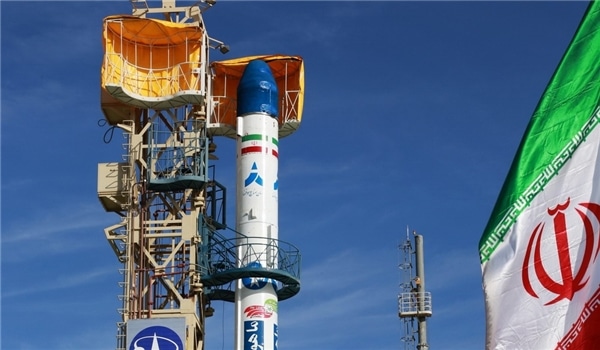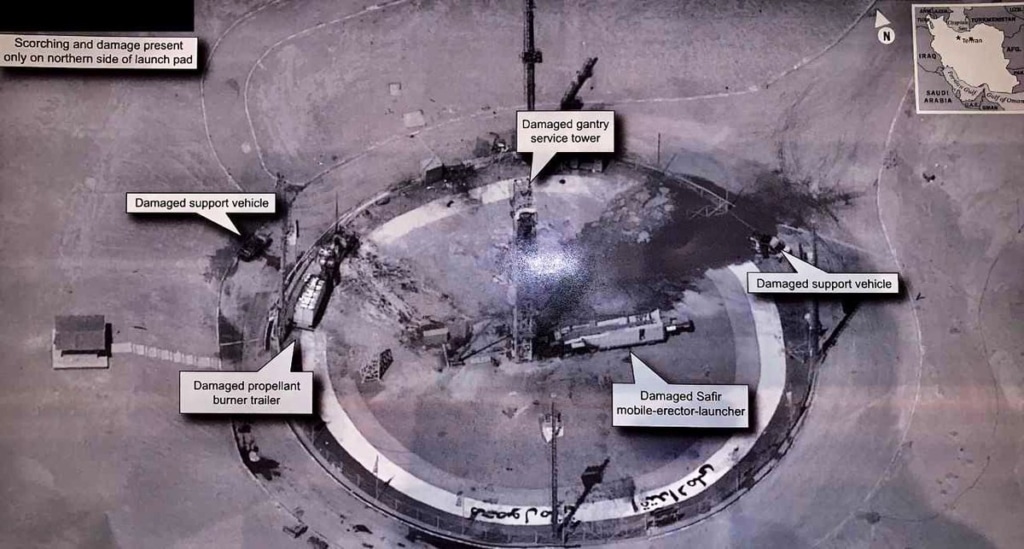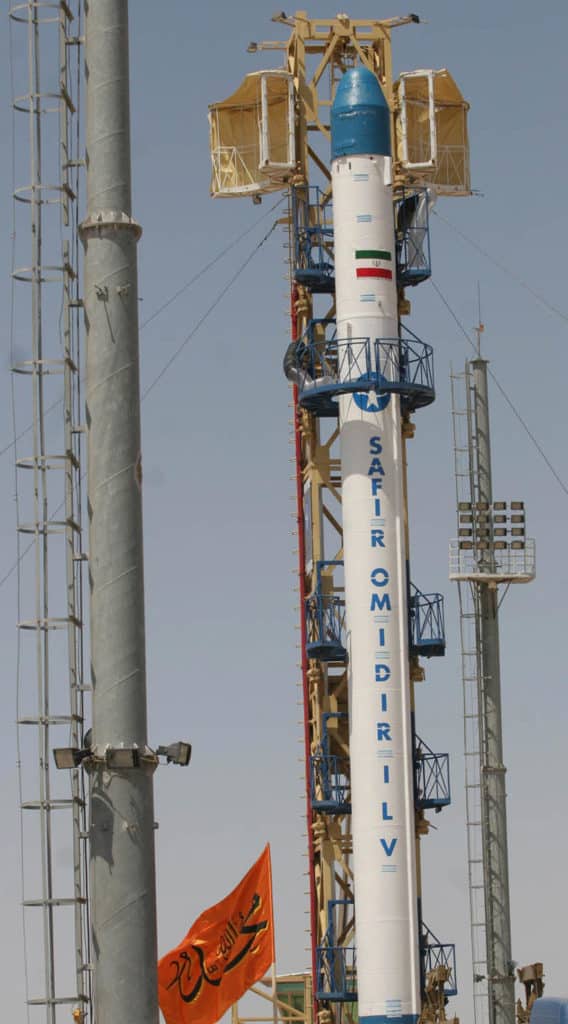The Safir is Iran’s first space launch vehicle (SLV) used to place satellites into low Earth orbit (LEO). As of October 2017, the Safir has placed four small satellites into LEO.
Safir at a Glance
- Originated from
- Iran
- Possessed by
- Iran
- Class
- Space Launch Vehicle (SLV)
- Basing
- Land-based, gantry launched
- Length
- 22 m (1st Stage: 13.5 m, 2nd Stage: 8.5 m)
- Diameter
- 1.25 m
- Launch weight
- 26,000 – 27,000 kg
- Payload
- 50 kg satellite
- Propulsion
- Two-stage, liquid propellant
- Range
- 300 – 350 km altitude (low-orbit)
- Status
- Operational
- In service
- 2009 – present

Safir rocket. Photo: Fars News Agency 
A satellite photo of a 2019 Safir launch failure tweeted by President Donald Trump. Photo: Donald Trump Twitter 
Iran’s Safir Omid rocket before launch. Photo: VAHIDREZA ALAI/AFP/Getty Images
Safir Development
Iran likely began developing an SLV shortly after the founding of the Iranian Space Agency in February 2004. The Safir is a two-stage variant of the Shahab-3, a medium range, single-stage, liquid fueled missile Iran tested almost exclusively from 1998 to 2006.1 One analyst has described the Safir as “essentially a Shahab-3 missile as the first stage with a small second stage on top.”2 How Iran developed a smaller second stage is unknown, although experts believe it uses an indigenously designed propulsion system.3
Although the Safir’s purpose is ostensibly to deliver satellites into orbit, technological progress in Iran’s space program could transfer to the country’s ballistic missile program. In February 2016, then-Director of National Intelligence James Clapper testified before the Senate Armed Services Committee that Iran’s progress on SLVs “provides Tehran with the means and motivation to develop longer-range missiles, including ICBMs.”4
Specifications
The Safir rocket measures 22.0 m in length (first stage: 13.5m, second stage: 8.5m), 1.25m in diameter, and weighs between 26,000 and 27,000 kg at launch.5 For guidance, the rocket relies on small steering engines and hard graphite jet vanes placed closely outside the rocket’s exhaust nozzle.6 Shortly after the Safir’s initial flight test, one report suggested that the rocket used smaller missile steering engines from the Russian SS-N-6 submarine launched ballistic missile. Later investigations determined that this conclusion lacked sufficient evidence, despite visual similarities between the engines.7
Satellite Launches
| Date | Number Launched | Notes 8 |
| February 6, 2019 | 1 | Failed satellite launch. |
| February 2, 2015 | 1 | Successful satellite launch. |
| February 2, 2013 | 1 | Failed satellite launch. |
| September 2012 | 1 | Failed satellite launch. |
| May 23, 2012 | 1 | Failed satellite launch. |
| February 3, 2012 | 1 | Successful satellite launch. |
| June 15, 2011 | 1 | Successful satellite launch. |
| February 3, 2009 | 1 | Successful satellite launch; first domestically produced satellite put in orbit. |
| August 17, 2008 | 1 | Failed flight test. |
Safir has undergone one known flight test and at least eight attempted satellite launches. The rocket’s flight test on August 17, 2008 failed due to an error in the second stage engine when the rocket was at an altitude of 150 km.9
After its first successful satellite launch on February 3, 2009, Iran became the ninth country to place a satellite into orbit using indigenous technology.10 The Safir placed a small, 27 kg satellite named Omid (‘Hope’) into a low Earth orbit between 250 and 325 km altitude.
A second Safir satellite launch in June 15, 2011 delivered the Rasad-1 (‘Observation’) satellite, Iran’s first satellite designed to transmit high-resolution imagery back to Earth’s surface.11 Weighing only 15 kg, the Rasad was placed into LEO at an altitude of 250 km.12
On February 3, 2012, the Safir’s third satellite launch placed the 50 kg Navid-e Elm-o Sanat (‘Promise of Science and Industry’) satellite into LEO.13
Iran attempted to place an unknown satellite into orbit on May 23, 2012 using the Safir, which likely failed. Satellite imagery of the Semnan launch site from May 2012 shows the site prepared for launch, and imagery from June 2012 shows blast marks similar to previous satellite launches. Iran did not acknowledge a test or attempted satellite launch during this time. 14 Satellite imagery documented a more calamitous failure in September or October 2012, showing significant damage to the Semnan site’s launch tower.15
Satellite imagery presented at a conference hosted by Israel’s Institute for National Security Studies indicates another failed launch on February 2, 2013.16
Iran conducted its fourth successful Safir satellite launch on February 2, 2015, placing the Fajr (‘Dawn’) satellite into LEO. The 50 kg satellite is comparable to other Iranian satellites, but distinguishes itself by being the first with an onboard propulsion system, enabling it to change its orbit to prolong its lifetime.17
In February 2019, Iran launched a Safir rocket that failed shortly after launch.18 Reports indicate the Safir rocket intended to carry the Doosti remote-sensing satellite.
In August 2019, President Donald Trump tweeted surveillance photos of the damaged launch pad at Semnan Launch Site.19 The tweet suggested that the Safir rocket had exploded during final launch preparations, though the United States denied any involvement.
Iranian Space Agency (ISA)
The ISA ostensibly pursues civilian and research goals, specifically the development of communication and remote sensing satellites, as well as launch vehicle technology.20 The Ministry of Information and Communication Technology, which takes direction from the Iran Space Council (ISC), oversees the agency. The Iranian president chairs the ISC, which is presided over by the Minister of Defense (MOD).21 Former Iranian MOD, Hossein Dehghan, was a former brigadier general of the Islamic Republic Guard Corps (IRGC) air force. The dual-use nature of rocket technology and the influence of the IRGC makes some analysts concerned that the ISA is developing long-range ballistic missiles under the guise of a space program.
Footnotes
- CSIS Missile Defense Project, “Iranian Missile Launches: 1988-Present,” Missile Threat, last updated August 17, 2017, https://missilethreat.csis.org/iranian-missile-launches-1988-present/.
- Laura Grego, “Iran’s Upcoming Simorgh Rocket Launch,” All Things Nuclear (blog), Union of Concerned Scientists, February 14, 2016, http://allthingsnuclear.org/lgrego/irans-upcoming-simorgh-rocket-launch.
- Peter Crail, “Iran Space Launch Raises Missile Concerns,” Arms Control Association, September 2, 2008, https://www.armscontrol.org/print/3314.
- James R. Clapper, Director of National Intelligence, Unclassified Statement for the Record on the Worldwide Threat Assessment of the US Intelligence Community for the Senate Armed Services Committee, February 9, 2016 https://www.armed-services.senate.gov/imo/media/doc/Clapper_02-09-16.pdf.
- “Safir” in IHS Jane’s Weapons: Strategic 2015-2016, ed. James O’Halloran (United Kingdom: IHS, 2015), 428-429.
- David Wright, “A Model of a Two-Stage Safir Launch Vehicle,” Union of Concerned Scientists, February 11, 2009, http://www.ucsusa.org/sites/default/files/legacy/assets/documents/nwgs/Safir-analysis-2-11-09.pdf.
- Ibid.
- CSIS Missile Defense Project, “Iranian Missile Launches: 1988-Present,” Missile Threat, August 17, 2017, 2017, https://missilethreat.csis.org/iranian-missile-launches-1988-present/.
- O’Halloran.
- “Iran Launches Homegrown Satellite,” BBC, February 3, 2009 http://news.bbc.co.uk/2/hi/middle_east/7866357.stm.
- “Iran Successfully Launches Satellite into Orbit,” Telegraph, June 17, 2011, http://www.telegraph.co.uk/news/worldnews/middleeast/iran/8581238/Iran-successfully-launches-satellite-into-orbit.html.
- O’Halloran.
- Tariq Malik, “Iran Launches Small Earth-Watching Satellite into Orbit: Report,” Space, February 3, 2012, https://www.space.com/14464-iran-launches-small-satellite-orbit.html.
- Laura Grego, “Iran’s Launch Today- and in the Future,” All Thing Nuclear (blog), January 28, 2013, http://allthingsnuclear.org/lgrego/irans-launch-today-and-in-the-future.
- Ibid.
- Anthony Cordesman, “Iran’s Rocket and Missile Forces and Strategic Options,” CSIS, October 7, 2014, 130, https://csis-prod.s3.amazonaws.com/s3fs-public/legacy_files/files/publication/141007_Iran_Rocket_Missile_forces.pdf.
- Laura Grego, “Iran’s Fourth Successful Satellite Launch,” All Things Nuclear (blog), February 2, 2015, http://allthingsnuclear.org/lgrego/irans-fourth-successful-satellite-launch.
- Sarah Lewin, “Satellite Photos Show Evidence of Iranian Rocket Launch. But Did It Fail?,” Space.com, February 7, 2019, https://www.space.com/43260-iran-second-satellite-launch-possible-failure.html.
- John Gambrell, “Mysterious Iran Rocket Blast Draws Trump Tweet, Tehran Response,” Military Times, August 31, 2019, https://www.militarytimes.com/news/your-military/2019/08/31/mysterious-iran-rocket-blast-draws-trump-tweet-tehran-response/.
- “Global Space Programs,” Space Foundation, https://www.spacefoundation.org/programs/public-policy-and-government-affairs/introduction-space/global-space-programs.
- “Iran Space Agency,” Iran Watch, August 31, 2009, http://www.iranwatch.org/iranian-entities/iranian-space-agency.